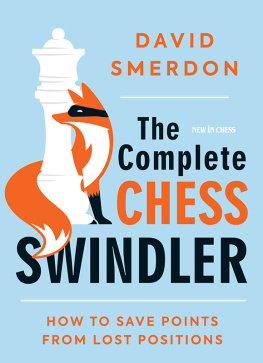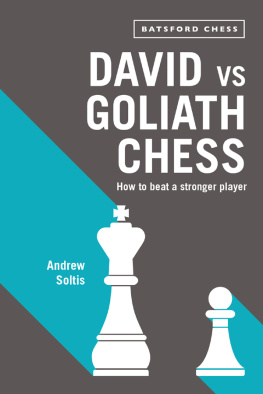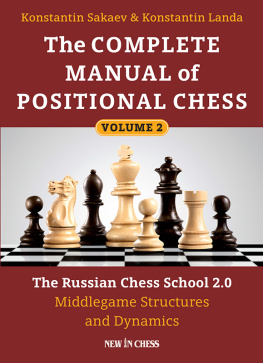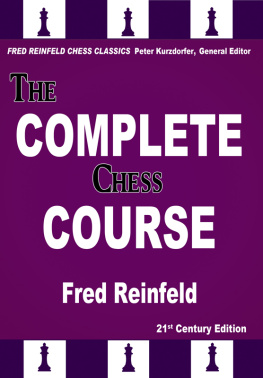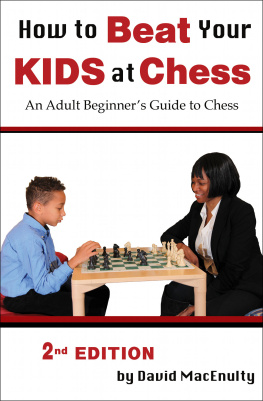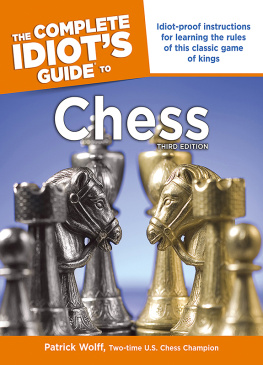David Smerdon - Chessable - The Complete Chess Swindler
Here you can read online David Smerdon - Chessable - The Complete Chess Swindler full text of the book (entire story) in english for free. Download pdf and epub, get meaning, cover and reviews about this ebook. genre: Home and family. Description of the work, (preface) as well as reviews are available. Best literature library LitArk.com created for fans of good reading and offers a wide selection of genres:
Romance novel
Science fiction
Adventure
Detective
Science
History
Home and family
Prose
Art
Politics
Computer
Non-fiction
Religion
Business
Children
Humor
Choose a favorite category and find really read worthwhile books. Enjoy immersion in the world of imagination, feel the emotions of the characters or learn something new for yourself, make an fascinating discovery.

- Book:Chessable - The Complete Chess Swindler
- Author:
- Genre:
- Rating:5 / 5
- Favourites:Add to favourites
- Your mark:
- 100
- 1
- 2
- 3
- 4
- 5
Chessable - The Complete Chess Swindler: summary, description and annotation
We offer to read an annotation, description, summary or preface (depends on what the author of the book "Chessable - The Complete Chess Swindler" wrote himself). If you haven't found the necessary information about the book — write in the comments, we will try to find it.
Chessable - The Complete Chess Swindler — read online for free the complete book (whole text) full work
Below is the text of the book, divided by pages. System saving the place of the last page read, allows you to conveniently read the book "Chessable - The Complete Chess Swindler" online for free, without having to search again every time where you left off. Put a bookmark, and you can go to the page where you finished reading at any time.
Font size:
Interval:
Bookmark:
[Event ?]
[Site ?]
[Date ????.??.??]
[Round ?]
[White Introduction]
[Black Introduction]
[Result *]
[FEN 8/8/8/2b4p/8/p5k1/3N4/7K w - - 0 91]
[SetUp 1]
{ Chess is in the last resort a battle of wits, not an exercise in mathematics. Theory helps you, but you have to fight. Hence our contempt for the stupid word swindle in chess - C.J.S. Purdy @@HeaderStart@@Semyon Furman - Jan Smejkal@@HeaderEnd@@ 91.Ne4+ Kf3 92.Nxc5 a2 and Furman soon resigned. For most of the spectators, the finish was rather dull. For most spectators, that is, except for one: Mikhail Tal. The former World Champion was watching on. As the British writer Leonard Barden recounts, Tal approached the board after the games end and asked Smejkal, What would you have done after 91.Nb3? Why, pawn to a2 of course! was the reply. Ah, said the Magician from Riga, with a twinkle in his eye. Then you would only have drawn. And with his trademark nonchalance, he pushed a few pieces: }
91. Nb3 a2 92. Nc1
{ A fantastic drawing idea is revealed, no doubt to both players horror. Promotion to a Queen or Rook is stalemate, while getting a new Bishop is no help with a Rooks pawn, even without the White Knight. As Tal started to walk away, Smejkal waved him back, announcing Aha! I can still win! Pawn to a1 equals Knight! Unphased, Tal reached back and played }
92 a1=N 93. Nb3
{ Leaving the grandmasters aghast. A picturesque swindle that, alas, never made it onto the scoresheets. Ill never be able to play like Tal. But let me share with you the closest Ive come to imitating him as a spectator. Fast-forward almost 50 years to 2017 and the game that inspired this book, at a less esteemed tournament with less esteemed players and certainly a less esteemed kibitzer: }
*
[Event ?]
[Site ?]
[Date ????.??.??]
[Round ?]
[White Introduction]
[Black Yi Liu vs. Aleksandar Wohl]
[Result *]
[FEN 5k1K/5p2/7P/2r3P1/1p6/2p5/2R5/8 w - - 0 38]
[SetUp 1]
{ Wohl, a legendary Australian IM, had been steadily outplaying his young opponent in this endgame and had assumed complete control. As a crowd of spectators watched, myself among them, the result seemed clear on both players faces. The White player had his head in his hands, looking completely dejected as his final seconds ticked down. From the sidelines, I spotted a cute swindling motif. Yi is a pretty good tactician, and I briefly thought his expressions were all part of some sort of theatrical bluff he was pulling on his older opponent. Alas, the gestures were legitimate angst. As I was trying to evaluate a complicated Queen endgame, Yi let his clock run down to zero and resigned in the same motion. The spectators began to disperse. Allowing a respectful pause, as I assumed Tal had done, I approached and asked Aleks what he would have played if Yi had continued with }
38. h7
{ Aleks looked at me as if I had suggested the moon was made of cheese and reached out his hand for the b-pawn. But the Australian veteran has known me long enough to appreciate my swindling ways, and he paused to take a second look at the position. Ahh!, he exclaimed. It was then that both players realized the game was far from over, and that White has some serious self-stalemate chances: 38.h7!! b3!! 39.Rxc3! Rxc3 40.g6! is immediately a draw, for example. Another pretty line is 38.h7!! Rb5? 39.Rxc3 anyway! 39bxc3 40.g6! c2 41.gxf7 and there is still no way to avoid the draw. After a few minutes, Wohl cleverly suggested }
38 Rc8
{ Which is the only try for Black to keep winning chances. However, Whites not out of tricks yet: }
39. Rf2
{ At the time I suggested the inverted move-order 39.g6 Ke7 40.Kg7 fxg6 41.Re2 Kd6 42.Rf2 but the irrepressibly thorough Belgium FM Helmut Froeyman, who often comments on my blog, later pointed out that the ending after 42g5!! 43.Rf8 Rxf8 44.Kxf8 c2 45.h8=Q c1=Q leads to mate in 57 moves! Now g6 is an unstoppable threat. }
39 b3
{ 39c2 40.Rxc2 Rxc2 41.g6! leads to a draw, while 39Ke7 40.Kg7 b3 41.Rxf7 Ke6 42.Rf6 Kd5 43.Rf8 Rc7 44.Rf7 Rxf7 45.Kxf7 c2 46.h8=Q c1=Q also splits the point. }
40. g6 Ke7+ 41. Kg7 fxg6 42. Rf7+ Ke6 43. Rf6+ Kd5 44. Rf8
{ With an endgame that we agreed gave White excellent practical chances. It is notoriously more difficult to calculate how to escape the checks than to give them in these sorts of Queen endgames, especially in time trouble. In fact, with the help of tablebases, it turns out that White can hold the draw even against best play: }
44 Rc7+ 45. Rf7 Rxf7+ 46. Kxf7 c2 47. h8=Q c1=Q 48. Qd8+
{ With, apparently, a theoretical draw. Perhaps Yi would have held the draw from here, or perhaps not - perhaps it would be lost ninety percent of the time. But this isnt the point. The lesson here is that with a little more grit and a dash of optimism, White could have deployed a fiendishly cunning defensive resource that, at worst, would have made Black sweat hard for the full point, and at best would have secured an immediate draw. Ten percent is better than zero, which is all you can get from resigning. That evening, I wondered whether todays energetic young talents, even with - or perhaps because of - their use of computer engines and vast online materials, are somehow less motivated to look for swindles than players of former generations. After the wide research I conducted for this book, I am surprised at how little attention has been paid to swindles in modern chess training. This is especially strange given that this is a part of our game where improvement yields immediate dividends. You may never reap the benefits of, say, learning 20 moves of an obscure opening sideline or memorising the Philidor manoeuvre in the notorious Rook-and-Bishop versus Rook endgame. Though, see the Endgames chapter. On the other hand, we all get into lost positions often, and thus stealing an extra half or even full point every now and then will make a dramatic difference to both your rating and your tournament performances. There are two reasons why the majority of players ignore the study of swindling. The first is, surprisingly, the rise of computer chess. Make no mistake: computers have drastically improved chess training, and todays players advance faster and are much more likely to reach their full potential thanks to technological tools. But an unexpected side effect of these advancements is that we have forgotten the practical nature of the battle. We are obsessed with engine evaluations, treating them as gospel (which, incidentally, has led to the rise of armchair critics - but thats another story) . And that influences our own games, in which we strive to always play the best move as evaluated on the screen, to the exclusion of almost all other factors. I completely agree that a player should try to play the best moves - but I disagree that best always equals the engines first choice. The computer evaluates a position assuming that our opponent will play perfectly at every turn. This is true of engines that use alpha-beta pruning algorithms, which includes most engines such as Stockfish, Fritz etc. But this is not exactly true of the new generation of engines that use Monte Carlo tree search, such as AlphaZero, Leela Chess and its commercial clone Fat Fritz. In fact, these engines spit out evaluations in terms of percentages that are much more similar to how humans think about evaluating a position than the cold 0.00 we are all used to seeing.; it doesnt (and cannot) consider the myriad of important human factors in a contest, such as fatigue, time pressure, risk-aversion, complacency, frustration, impulsiveness the list goes on. The second reason for the neglect of swindle training is simpler: its hard! For a coach or a self-taught player, the amount of material available for other parts of the game, such as openings, endgames or tactics, is overwhelming. But where does one start training how to swindle? You cant search a database for games with swindles, and even if you could, what would you learn? I sympathise with coaches who want to help their students study swindling and chess psychology in general but simply cant find any relevant materials. Most of the advice Ive heard or read has been vague, ranging from optimistic sentiments such as hang in there, because blunders do happen to the slightly more useful train your tactics so you are ready when opportunities arise. However, theres a big difference between winning a game because your opponent blundered all on his own, and setting up a swindle that actively encourages the decisive blunder. But a student seeking to learn the valuable art of swindling is liable to wind up disappointed; engines are clueless, databases are useless, and there have been virtually no good books devoted to the topic since the 1950s. This book has grown considerably since my initial concept of an anthology of beautiful swindles. As I embarked upon my quest to collect examples, I started to appreciate why past authors have been wary to touch the subject. There are a few collections showcasing chess curiosities that have been meticulously assembled by noted enthusiasts such as Israel Horowitz, Tim Krabbe, Ger van Perlo, Yochanan Afek and Amatzia Avni. I now appreciate what these authors must have gone through in their research, and you will find details of these superbly entertaining resources in the bibliography. Luckily, thanks to the fact that I am addicted to watching chess tournaments online, not a good personality trait for a researcher, and that I meticulously file interesting examples on my computer, a significantly more useful personality trait for a researcher, my database of modern swindles was already quite large. But for this book, I wanted more, and so I took a modern approach: crowd-sourcing. On social media, blogs and the like, I put out a call to the chess community to send me their best swindles. The response was overwhelming. Soon, my inbox was flooded with stories of games featuring horrific blunders, outrageous gamesmanship, and even blatant cheating. The filtering task was much more laborious than I expected. Part of the problem, as Afek noted to me, is that there is not a consistent definition of swindle in chess terminology. Jonathan Rogers, writing in Kingpin magazine, calls it Perhaps the best example of an abused chess word. I painstakingly filtered through the games until I was left with over 800 examples of the purest gems, resulting in what I am sure is the largest collection of chess swindles in the world. Along the way, I discovered some miraculous escapes and mouth-watering trickery. But more significantly, I noticed familiar patterns among the games. I began to realise that this book could not only redress the glaring lack of material in the chess literature on pure swindles, but also be a useful instructional tool for would-be Swindlers. I dont mean to trumpet this book as the godsend to fill this vacuum; I would be very happy if more (and better!) books were written on swindles in the future, as this is a topic that fascinates me. But until then, Ive done my best to put together as informative and as entertaining a guide as possible to this wonderful world. The general flow of the book is as follows. First, we look at the most common psychological biases that affect chess players over the board. Next, we discuss the most important attributes and skills the Swindler needs to exploit these biases. Finally, we bring these parts together to focus on how to train yourself to become a better Swindler. To that end, Ive added some swindle-specific puzzles at the end of the book that are designed to help train your swindling skills. They are different from most chess exercises in the sense that computers wont be any help to you; in fact, quite often the engines best move will not be the correct answer, as it often doesnt reflect a players best chance of setting up a swindle. On the other hand, there are some puzzles in which you will try to avoid a swindle and win a won game, where, reassuringly, the computer typically agrees with the solutions. And along these lines, youll find that my annotations in the main games often dont match the computers evaluations. I might award a brilliancy (!!) for a move that doesnt even make the engines top choices but sets up a devious swindle, or call a move a blunder (??) when it technically forces checkmate but drastically narrows the margin for error. Speaking of grammar: I have capitalised Black and White when these words refer to the generic players, while the corresponding adjectives are not capitalised (as in the Black Queen) . I generally stick to the present tense when annotating a game, except when it seems to make more sense to tell an anecdote or a story in the past tense, like in the above examples. Proponents of correspondence chess may shudder at such blasphemy in a chess book - but here, too, I will demonstrate the benefits of learning to swindle by showing some remarkable rebounds within their hallowed world. A quick note on the structure. I have tried to follow some sort of natural flow, as well as keeping congruence between the sections - for example, each psychological bias maps directly with a specific type of trap that the Swindler can employ to exploit it. The book is made up of several parts, with each part containing several mini-chapters. Some of the chapters are quite short, containing a few or even just one example. This reflects my own preference when reading anything instructional; there are many new and unusual themes discussed in these pages, and I find that it is much easier to absorb a key idea if it is self-contained in its own chapter. Above all, Ive tried not to forget what got me interested in this project in the first place: swindles are fun! I hope the examples in this book will inspire and entertain you as much as theyve delighted me. May you always win your winning positions, and may Caissa smile on you for the rest. GM David Smerdon, Brisbane January 2020 }
Next pageFont size:
Interval:
Bookmark:
Similar books «Chessable - The Complete Chess Swindler»
Look at similar books to Chessable - The Complete Chess Swindler. We have selected literature similar in name and meaning in the hope of providing readers with more options to find new, interesting, not yet read works.
Discussion, reviews of the book Chessable - The Complete Chess Swindler and just readers' own opinions. Leave your comments, write what you think about the work, its meaning or the main characters. Specify what exactly you liked and what you didn't like, and why you think so.

